The last Premier League game of week 33 was played on Monday night, between Tottenham and Everton at the Tottenham Hotspur Stadium. Both teams were fighting to be in the European competitions next season, treating this as an important battle. After 90 minutes of play, the home team won by Michael Keane’s own goal and sealed all three points.
In this tactical analysis, we will dissect every phase of plays in this clash. The change of tactics by Carlo Ancelotti is another focus of this analysis.
Lineups
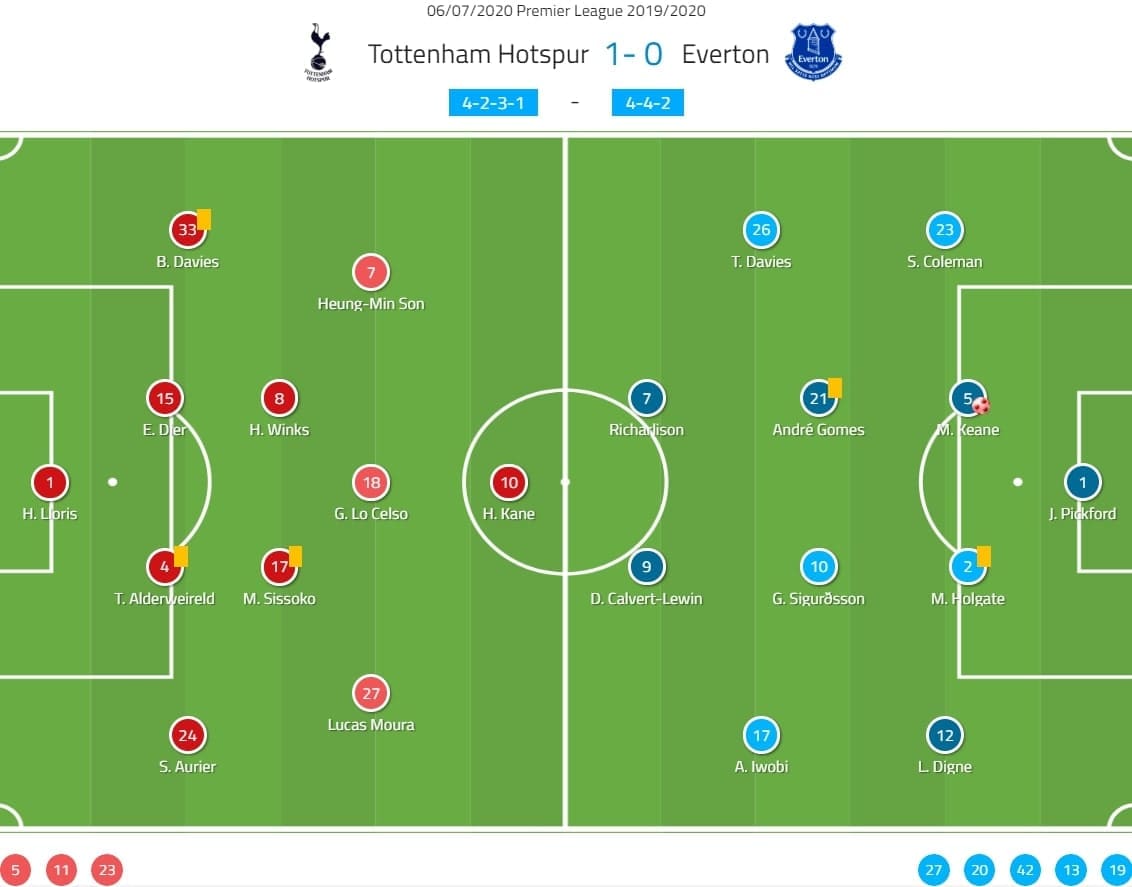
Tottenham were playing in a 4-2-3-1 after suffering from the Sheffield defeat. José Mourinho has made several changes, using Toby Alderweireld to partner Eric Dier as the centre-back. Steven Bergwijn was kept on the bench as Harry Winks returned to the midfield.
After the exciting victory over Leicester, Everton continued with a strong squad and only one change was made: Anthony Gordon was replaced by Tom Davies, who played as a right-winger. This was a 4-4-2 formation on paper, but the positional interchanges have made the formation less important.
Tottenham offensive style of play
When talking Mourinho and Tottenham, the 3-2 build-up shape was the first that comes to our mind. However, the Portuguese coach has tweaked his tactics slightly, hence, abandoned this predictable shape against this passive pressing opponent.
In general, Winks was the main man in the build-up, forming a 2-1 or a back three with the centre-backs. Meanwhile, Moussa Sissoko pushed himself higher to occupy the second line, keeping Winks away from instant and early pressure. To compensate and provide an extra progressive option, Giovani Lo Celso might drop deeper from his initial position.
With at least three players at the first line, Tottenham enjoyed a 3 v 2 numerical advantage to overload the Everton strikers. This means at least one player was free to play the out-ball.
In this example, the opposition first line was drawn near Alderweireld and Winks, Dier became the free player. As mentioned, Lo Celso would drop to provide a passing option. The Argentine midfielder released the Dier, who had a better body angle to play the out-ball and this helped Tottenham progressed play to the central third.
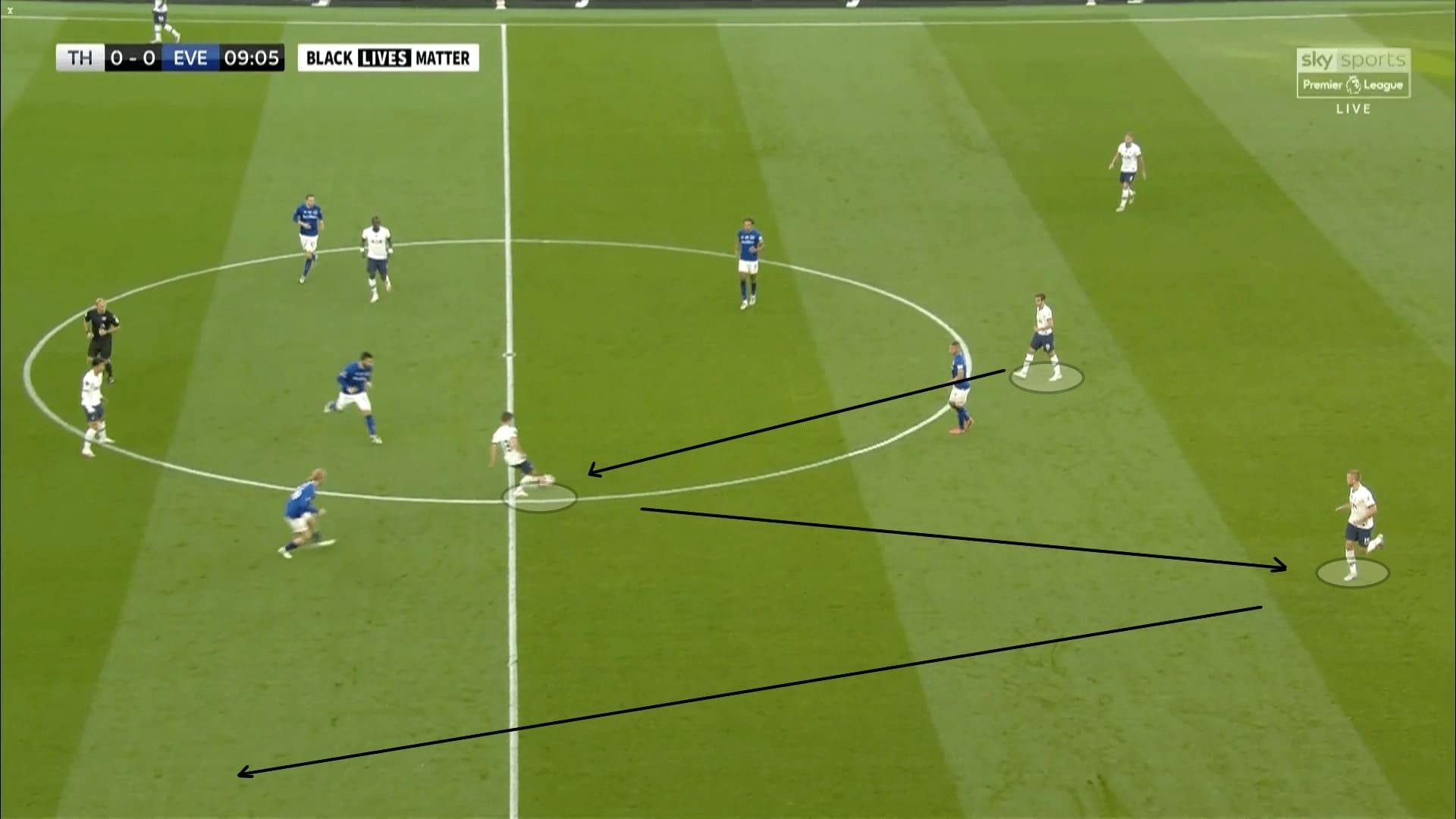
So, the main difference in Tottenham’s first phase was the positioning of Ben Davies, who was given the freedom to push higher and occupy the outer zone. Serge Aurier has the exact same responsibility – occupying the right outer zone. These two players provided the width and stretched the Everton defence.
For Heung-min Son and Lucas Moura, they stayed narrow at the half-spaces and between the lines. Their positionings were vital to manipulate the behaviours of the second defensive line, so the opposition strikers were pressing without support. This facilitated the 3 v 2 numerical overload as explained above.
The below example was an execution of the Tottenham attack. When Winks provided an additional layer in the first phase, the pressure was kept away from the first line and allowed Dier to switch the ball to Alderweireld easily.
We also drew the positionings of Son, Moura and Sissoko. These players were functioning in a collective manner – the Everton midfield three was not supporting Dominic Calvert-Lewin and Richarlison. This allowed Tottenham to progress plays.
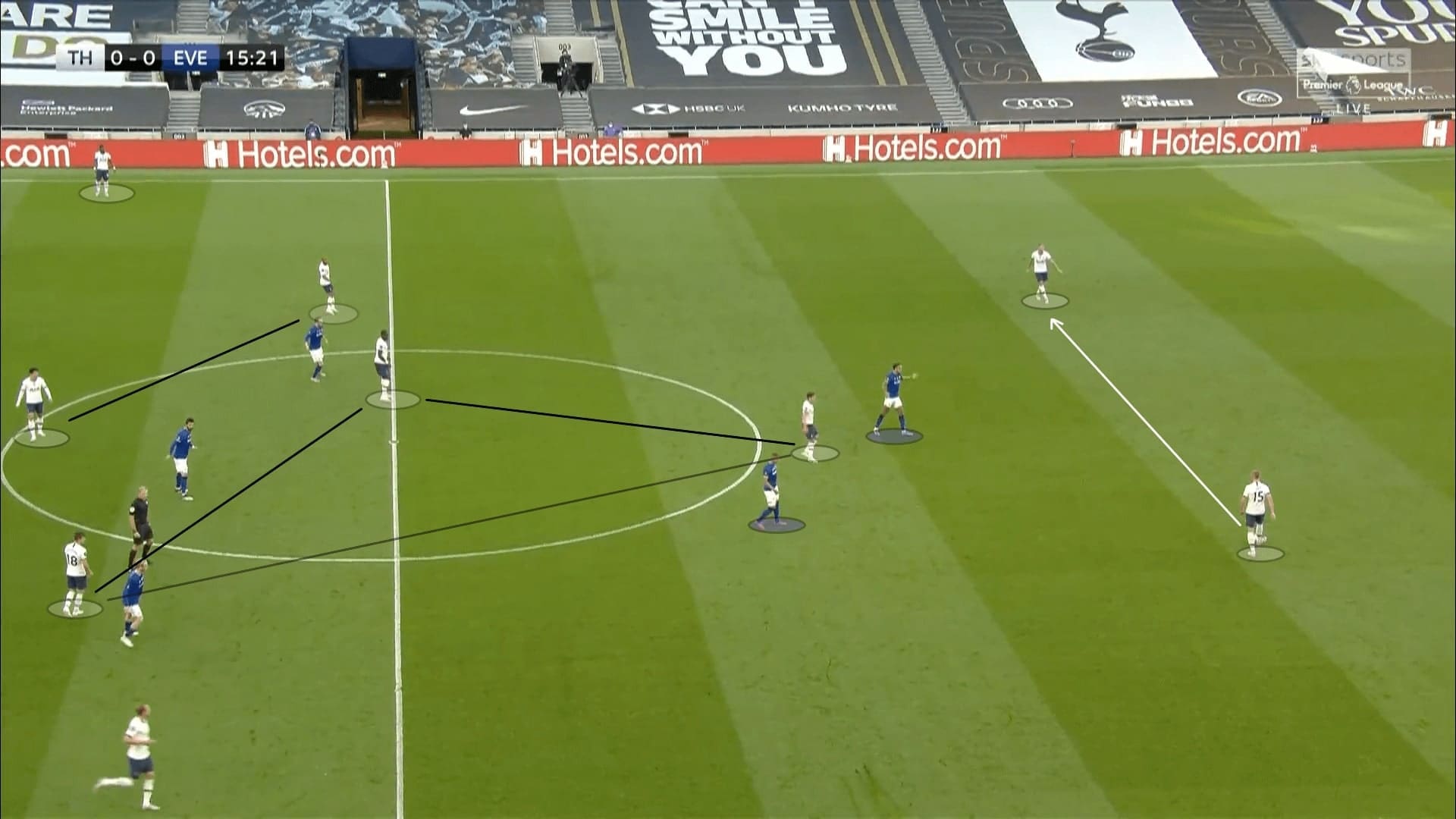
Despite having the ability and conditions to play out from the back, Tottenham did not really break the defensive block. The major issue was also a structural one, as the front players drew Everton defence narrow, the block was compact, and spaces were tight. Mourinho’s men were not too comfortable to play quick combinations centrally.
Also, the tempo and rhythm were too slow and lacked dynamism often. The ball was played softly often, which allowed Everton to shift the marking man-to-man, putting pressure from the receiver’s back. Considering neither B. Davies nor Aurier could create the dynamics by their own, the attacks were ineffective and not many big chances were created.
Here, as an example, B. Davies has missed the best timing to play the in-ball to the front players. The only available option remaining was Lo Celso, who was surrounded by three opponents. Hardly could Tottenham progress in such a situation.
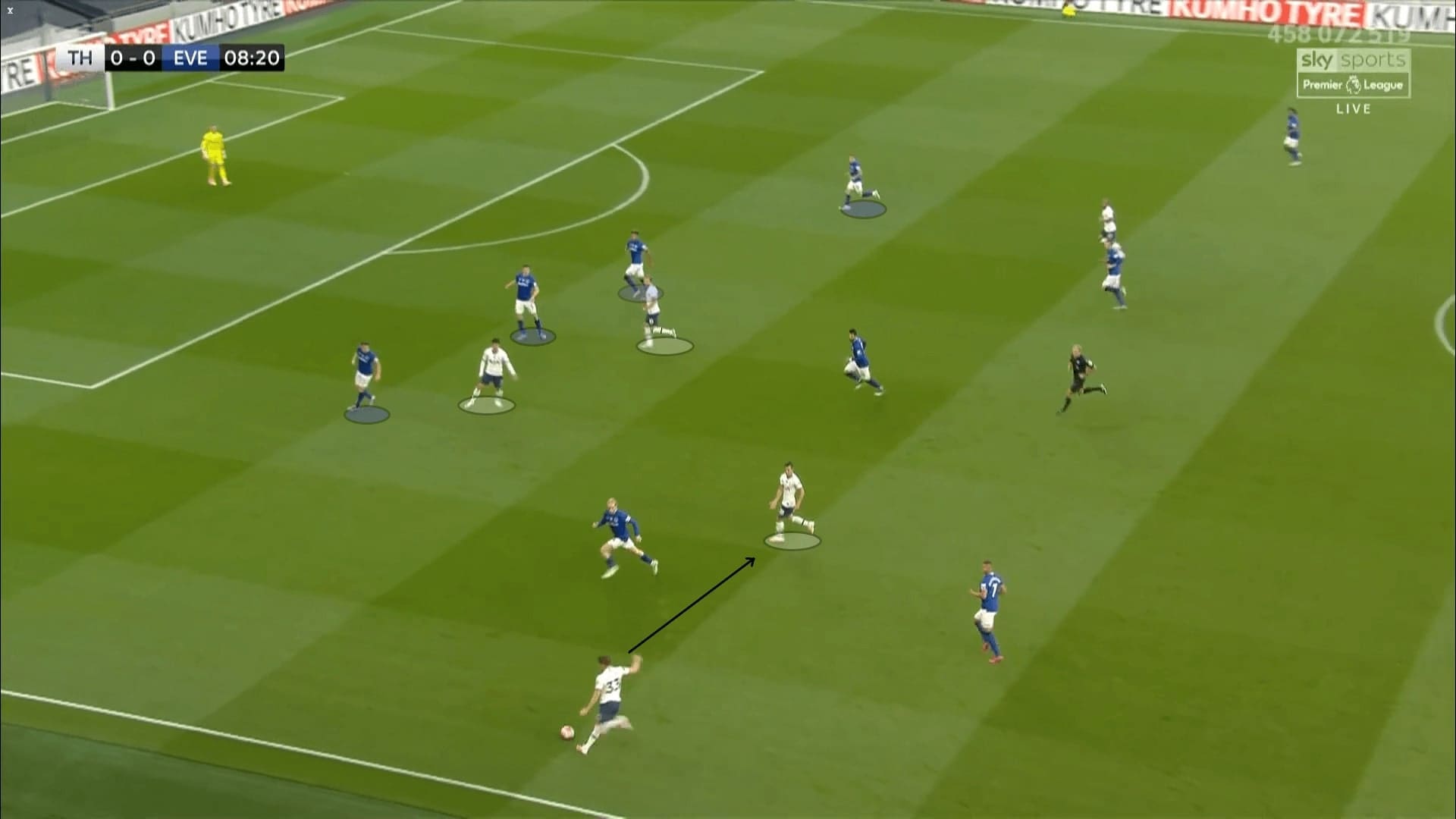
Everton’s midblock
Ancelotti was fully aware of the offensive tactics of Mourinho, especial the wide positionings of Aurier at flank. Therefore, the left-winger, Alex Iwobi was tasked to stay extremely deep, even serving as a false wing-back to maintain an accessible distance to the Ivorian player.
Consequently, Everton only had five players, which was a 2-3 shape to press. As explained, the first line was always underloaded in the Tottenham first phase, their pressing efforts were in vain on most occasions.
The midfield formed by T. Davies, Gylfi Sigurðsson and André Gomes was doing quite well to shift simultaneously. The work rate should be appreciated as their horizontal coverage was quite large, and thanks to the slow tempo of the opposition, this line often arrived on time to shield the ball side.
Here, we illustrate the defensive shape of Everton. Since Iwobi was dropping and behaving as a false wing-back, the Everton original back four could man-mark and follow the corresponding target. So, Séamus Coleman followed Son out in this case, while T. Davies was tracking B. Davies at flank. Given the close proximity on the ball side, Tottenham were unable to penetrate in tight spaces and circulate the ball was the preferred option.
The importance of Iwobi’s positioning was to prevent the long diagonals that hit the opposite flank. As a result, Tottenham tended to circulate the ball at the backline and this bought time for Everton to reorganize the defence.
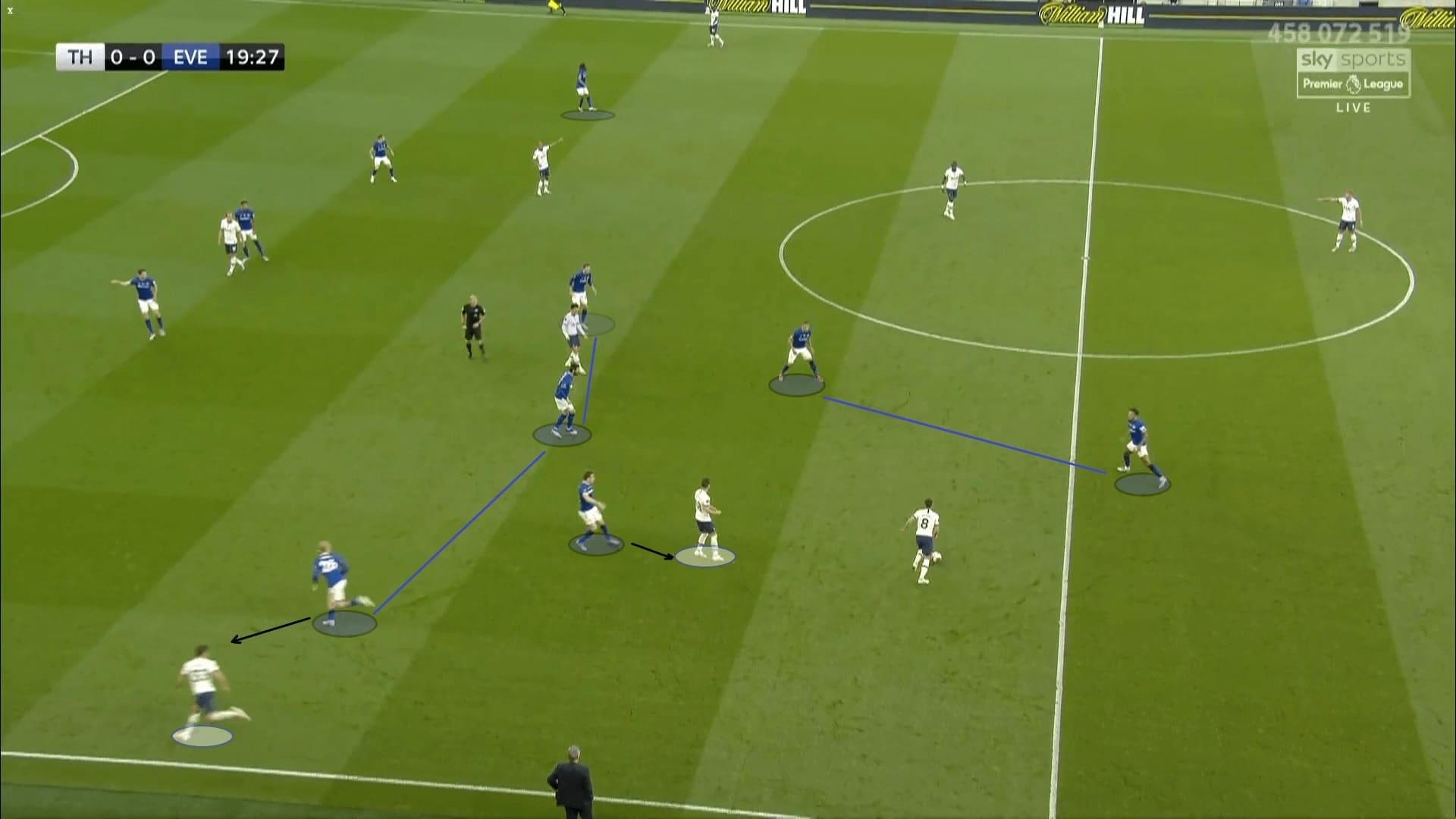
Another example on the Everton defence was shown here, the 5-3-2 shape was quite clear. Notice the behaviour of the players when Sissoko received the ball and progressed as the free man. Sigurðsson, the widest midfielder prioritized to maintain the compactness and protect the zone instead of approaching the opposition.
The curved run of Sigurðsson which shadowed Moura has denied the progressive option of Tottenham. Meanwhile, the other two were maintaining even distances with the partners and kept the shape complete. Since Sissoko was not strong at creating the dynamics himself, shadowing the front players already kept the defence safe.
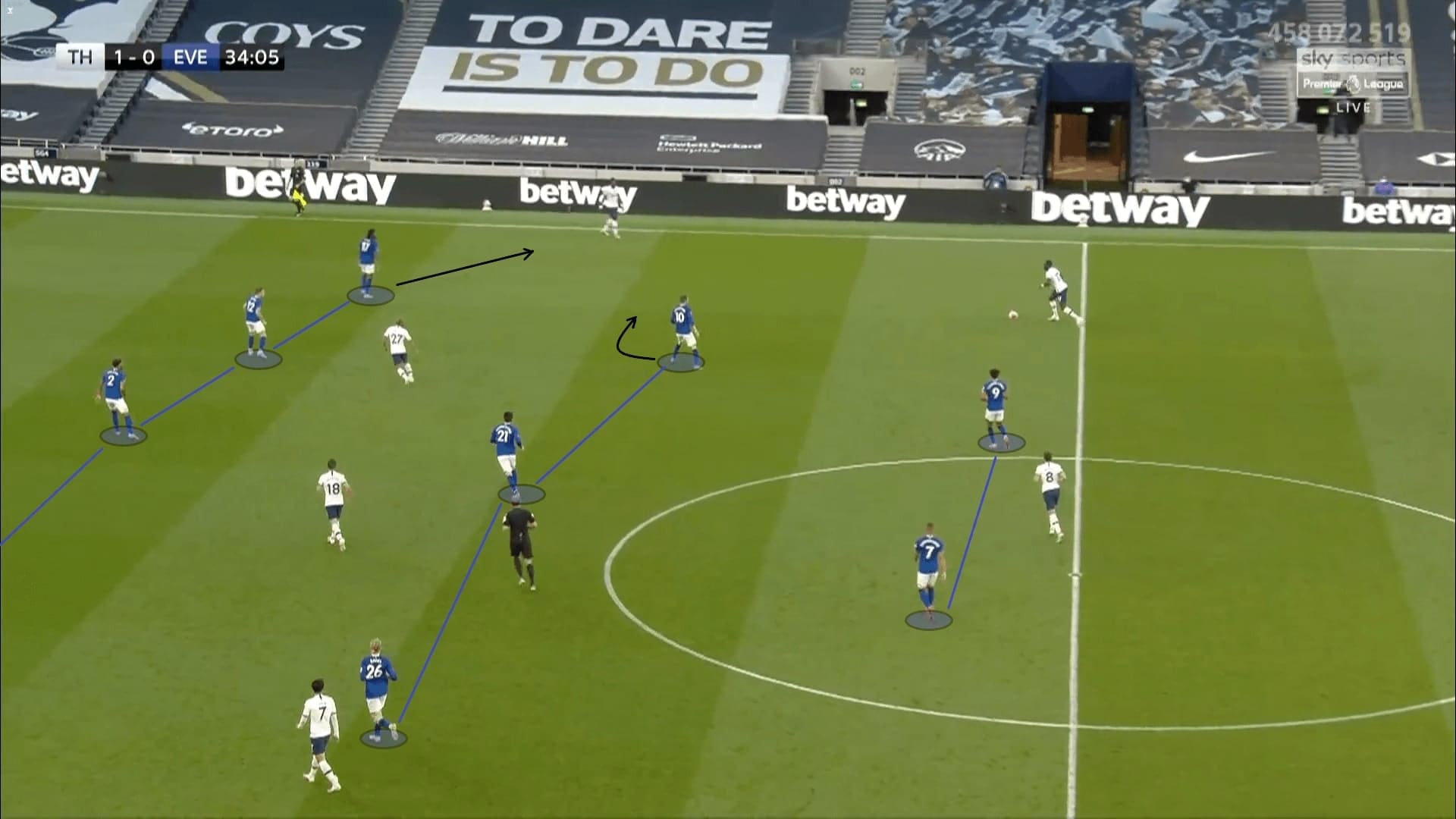
Tottenham defensive style of play
Mourinho’s Tottenham were not pressing, we expected this as maintaining the compactness of the defence was the top priority. The home team defended in a 4-5-1 in general, and varied to a 4-2-3-1 (wingers inverting) or a 4-4-2 (Lo Celso moved higher). This block always overloaded the central area and covered the defence.
Therefore, the defensive impact of Harry Kane was negligible as either centre-back could bring the ball and bypass this layer. Although Lo Celso could step up, this was nullified by Gomes forming an additional layer, Tottenham were still underloaded in a 2 v 3. Below is an example that Kane could not prevent Keane from carrying the ball forward. And, the second line might be disrupted when Iwobi and an Everton striker dropped behind the midfield. Lo Celso had to drop deeper and shut the passing lane to Richarlison.
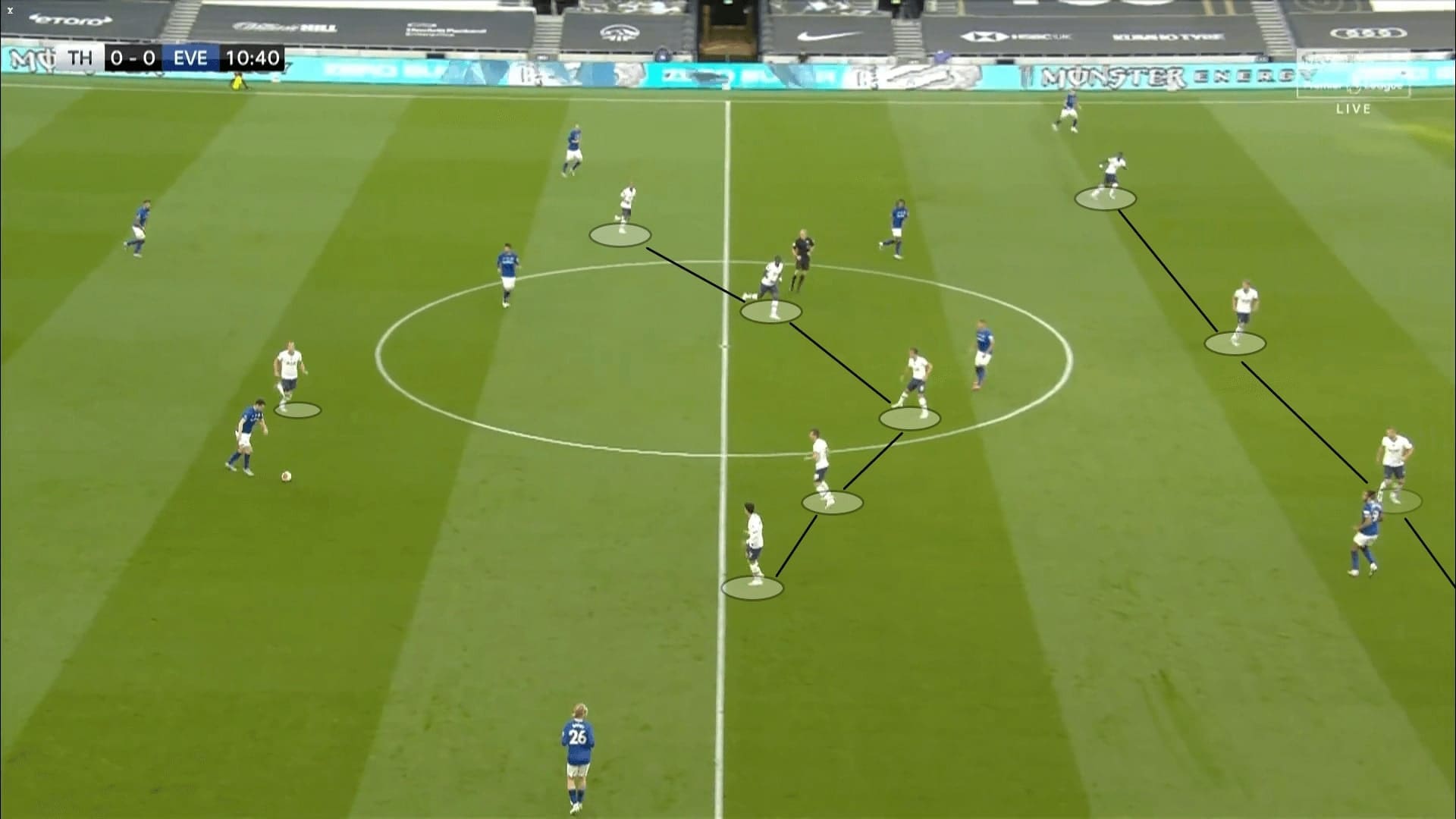
On occasions, Son or Moura would step up and cover Kane, but this often leaves the wide areas vacuum. Tottenham wing-backs were not covering the wide options as Coleman and Lucas Digne occupied the last line often.
Winks and Sissoko were affected by the opponents’ behaviour quite often in this game. However, their defensive efforts, track of runs and shadowing the options were vital to the defensive solidity.
As an example, the gap was generated between Dier and B. Davies as Coleman drew the left-back out of position. T. Davies was quick to recognize and exploit those spaces, while Yerry Mina carried the ball forward as explained. Thanks to the defensive positionings of Winks, which covered T. Davies, Tottenham were safe. If not, the Evertonian already entered the offensive third or even into the penalty box.
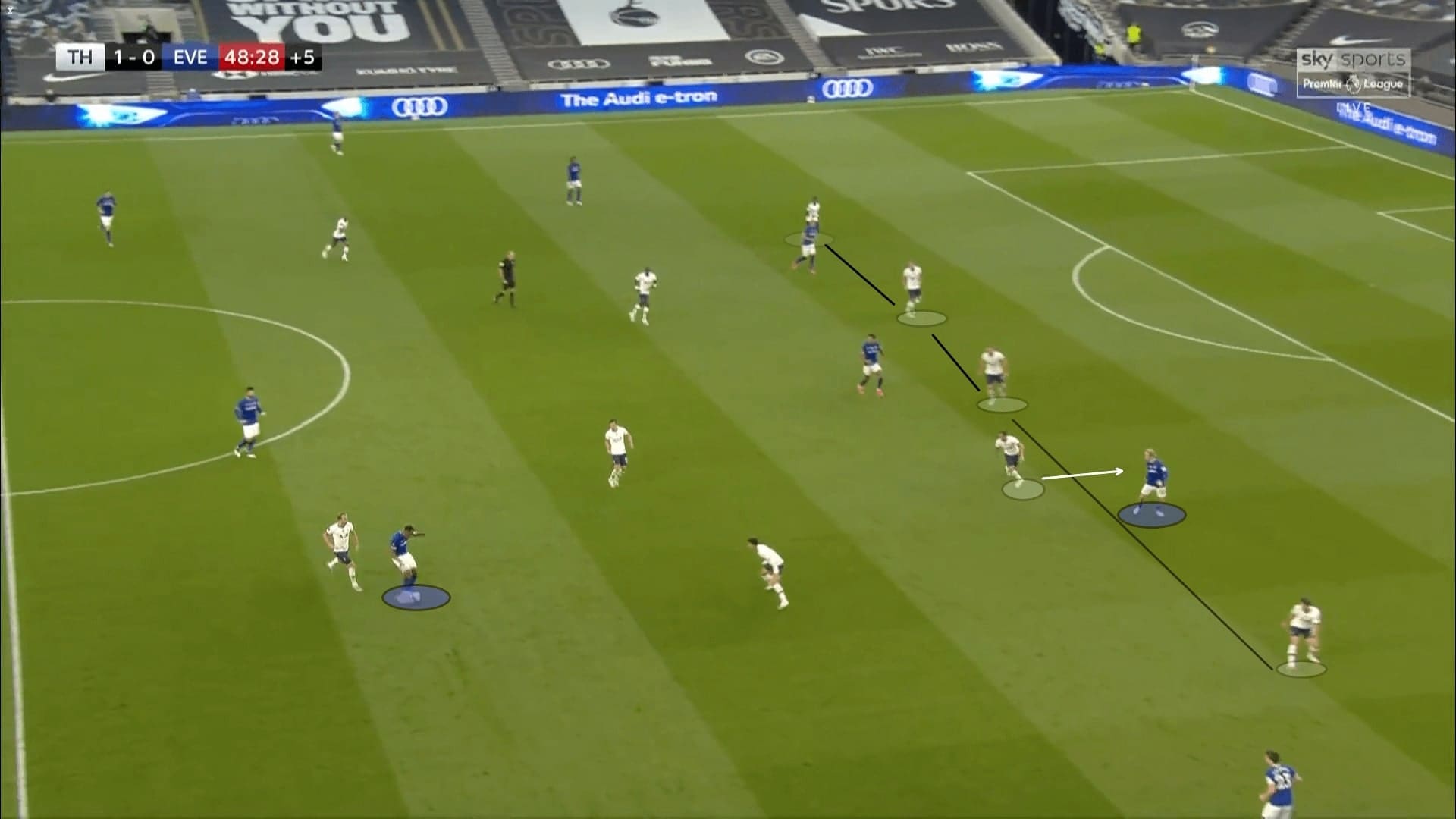
Everton adopted hybrid offensive tactics
Once again, Ancelotti’s team was attacking in a very unpredictable way. The players switched the positions and the role on paper was only a reference. The shape could be a 2-3-2-3 or a 2-3-5, depending on the situations. Both full-backs: Digne and Coleman were staying in an advanced position and provided the width.
In general, the first layer was the centre-backs, while Gomes stayed at the centre of the second layer. T. Davies was roaming on the right while Sigurðsson was on the left. This setup allowed Everton to find the free player in the first phase because of the offensive width and depth offered.
Against Kane only, the centre-back always enjoyed a 2 v 1 overload and one of them could carry the ball forward, we have explained. The second line could stretch Tottenham midfield, either creating spaces for at the half-spaces or opening the central passing lane if the opposition pressed.
However, the relatively large distances at the second line hindered the circulation of the ball. The players lacked the interconnectedness to bypass pressure with ground passes nearby. As an example, T. Davies could not play the ball back to the centre as no visible option was available.
As a result, the Evertonians were entering the offensive third with long passes. That’s why I described their offensive performance as a hybrid tactic. The intention was to use the build-up plays for progression, but, the main method to reach the higher region was using direct passes (cross-field balls/diagonal passes).
This was the dilemma of T. Davies here, who played long to bypass Son’s pressure and reached Coleman and Richarlison’s zone directly.
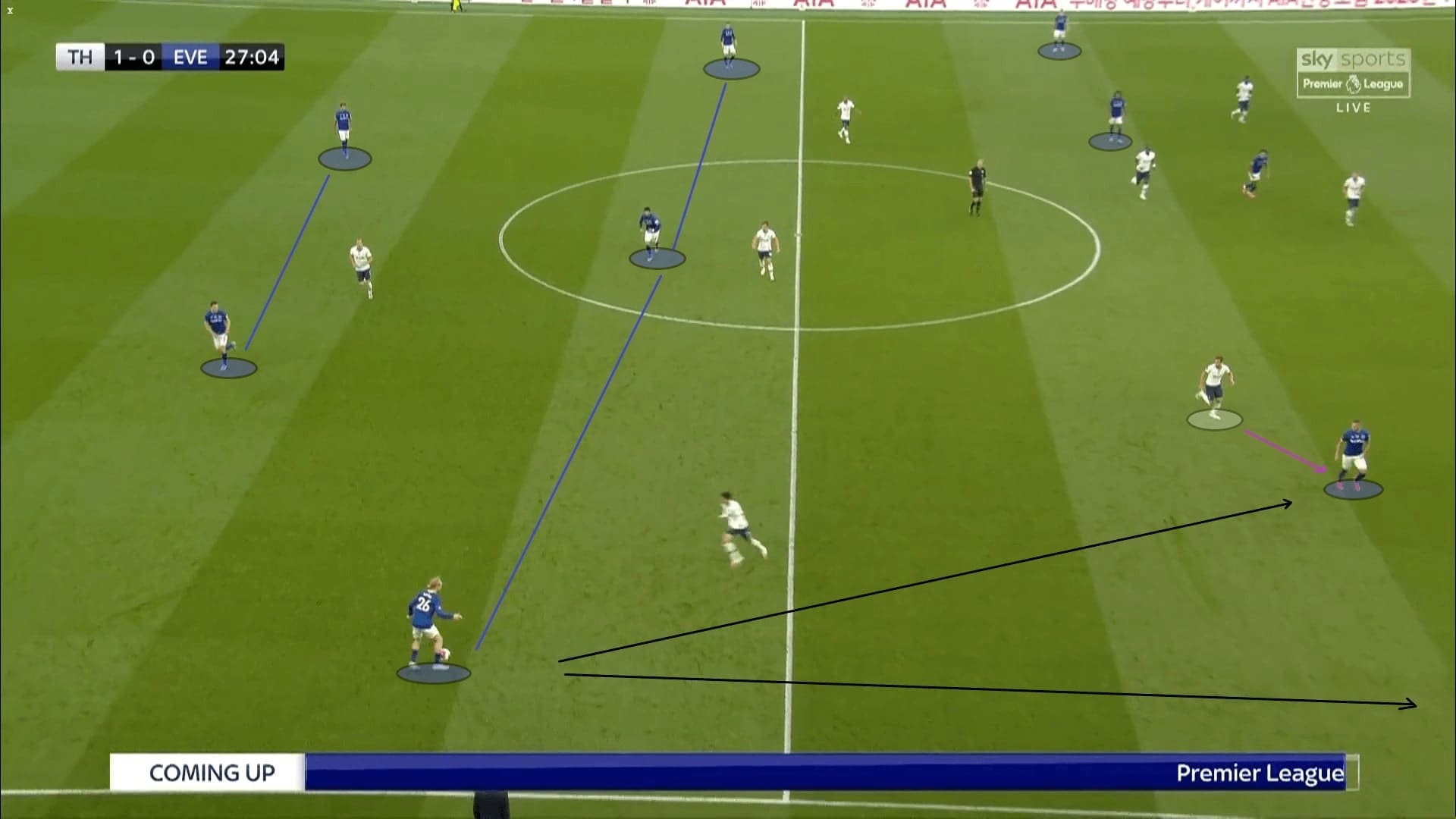
Given the unpredictability and the extra time to read a long pass, this strategy was suboptimal. Offensively, Everton struggled a bit in the first half, though a good opportunity was generated with these elements.
Here, Calvert-Lewin released Gomes – the third man. Iwobi’s initial narrow positioning was conducive to exploit spaces created by the dropping striker, who took Alderweireld out of position. Meanwhile, Richarlison occupied another centre-back and kept Dier with him until the last moment.
However, this was a rare case and was originated from a Tottenham failed press. Also, the long passes are difficult to control and Iwobi could not generate a shot in this case.
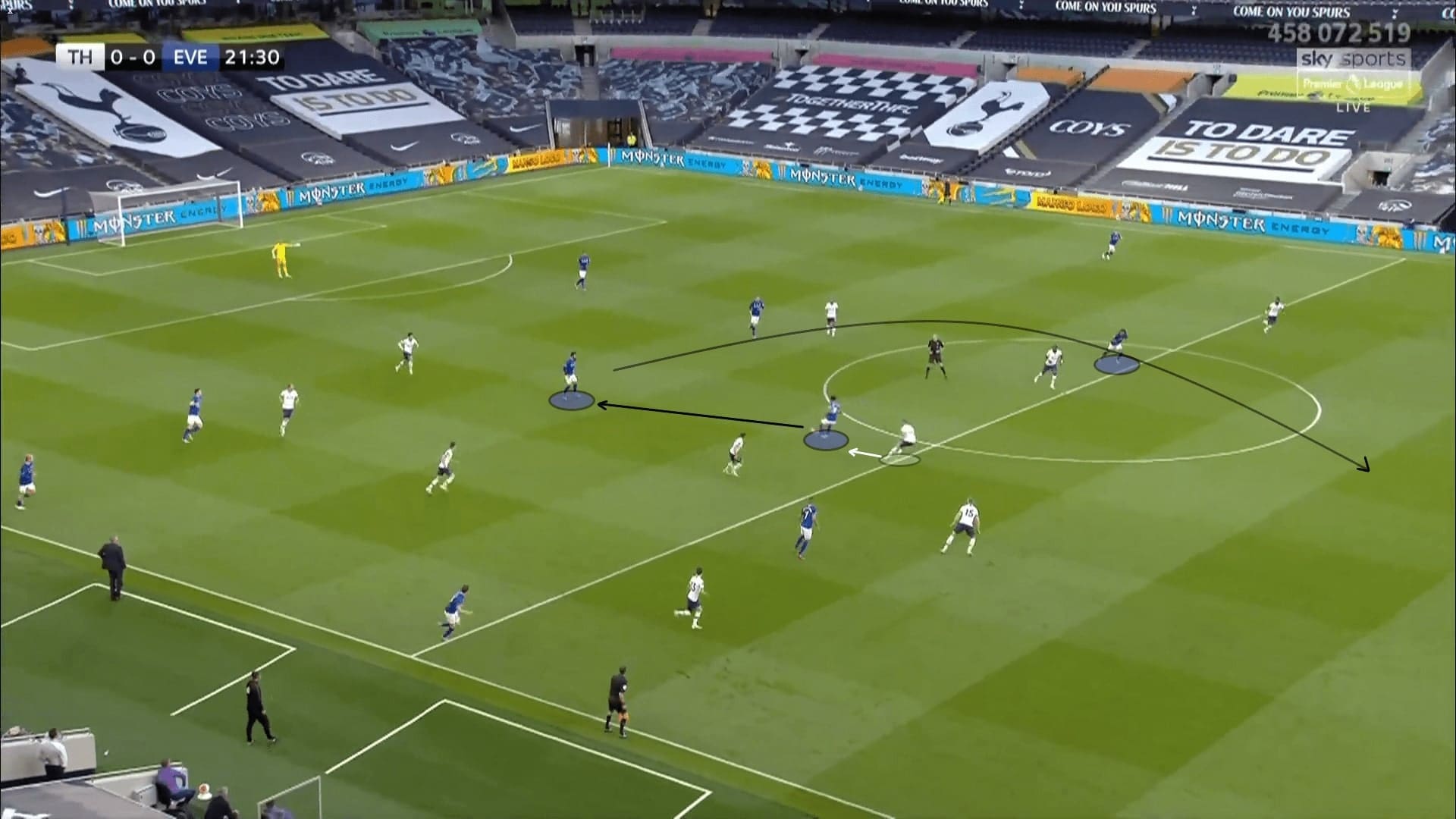
Second half changes
Since the offensive tactics in the first half were not good enough, Ancelotti changed a lot by using Gordon to replace Iwobi. Now, Sigurðsson went to the left and T. Davies had the freedom to roam his position. Gordon’s energy has created some dynamics for the away team, allowing Everton to progress on the ground.
Here, T. Davies and Gomes operated as a double pivot, as Gordon was at the half-spaces. The biggest difference was the behaviour to manipulate the midfield, this time, three players were doing this. The effects were greater when comparing to the efforts in the first half.
Three player – Sigurðsson, Richarlison and Gordon was stretching the Tottenham pivot. This allowed Mina to exploit the horizontal gaps and pick an option freely.
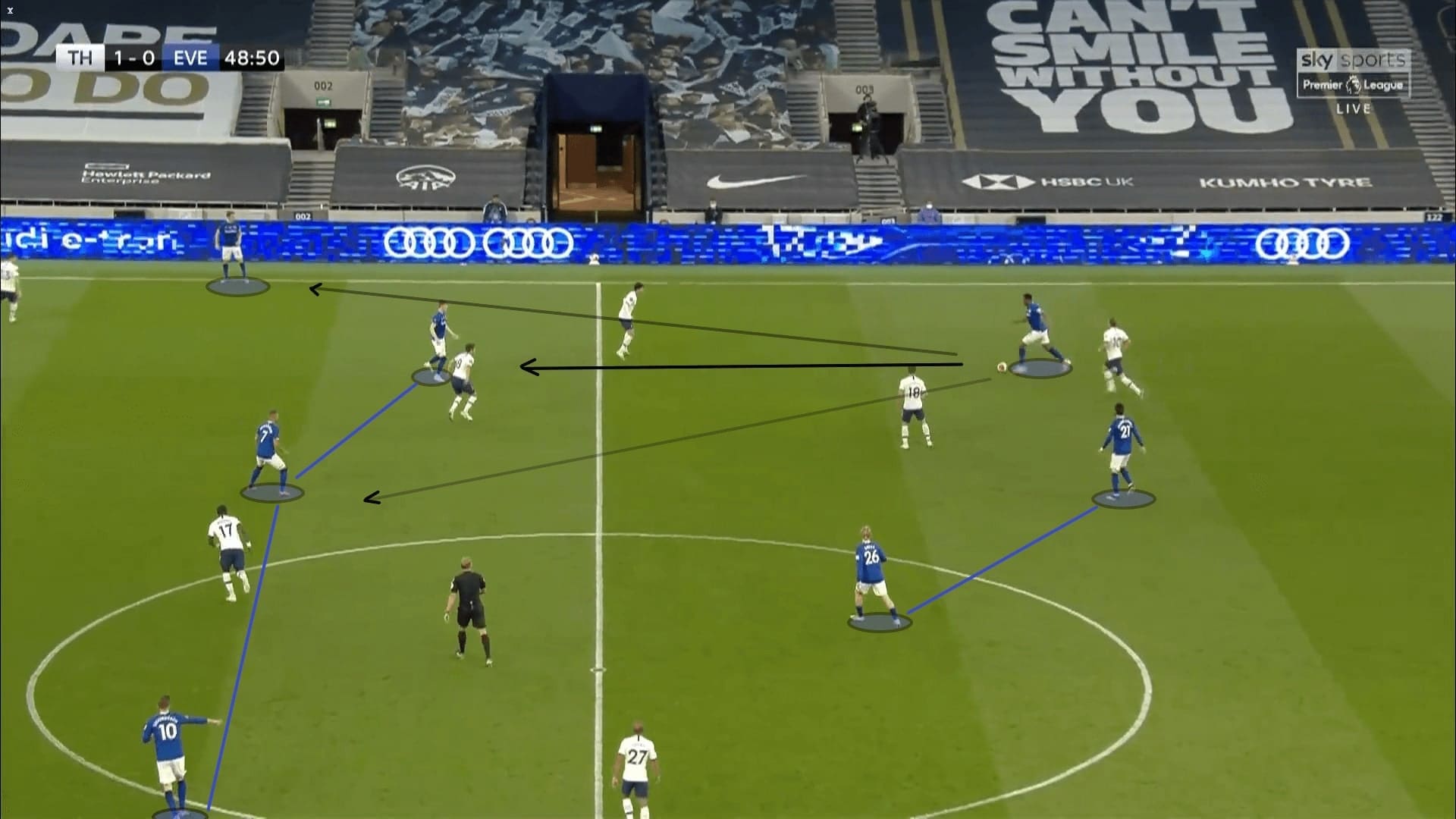
Dropping to the half-spaces was not the only function of Gordon. Instead, his off-the-ball movements disrupted the defence as well. As an example, he was keen to run into spaces behind the defence, we showed this below.
Here, T. Davies reverted to his original role, operating at the right flank. Thanks to Gordon’s forward run which brought Winks away, Calvert-Lewin appeared as the free option at the second line.
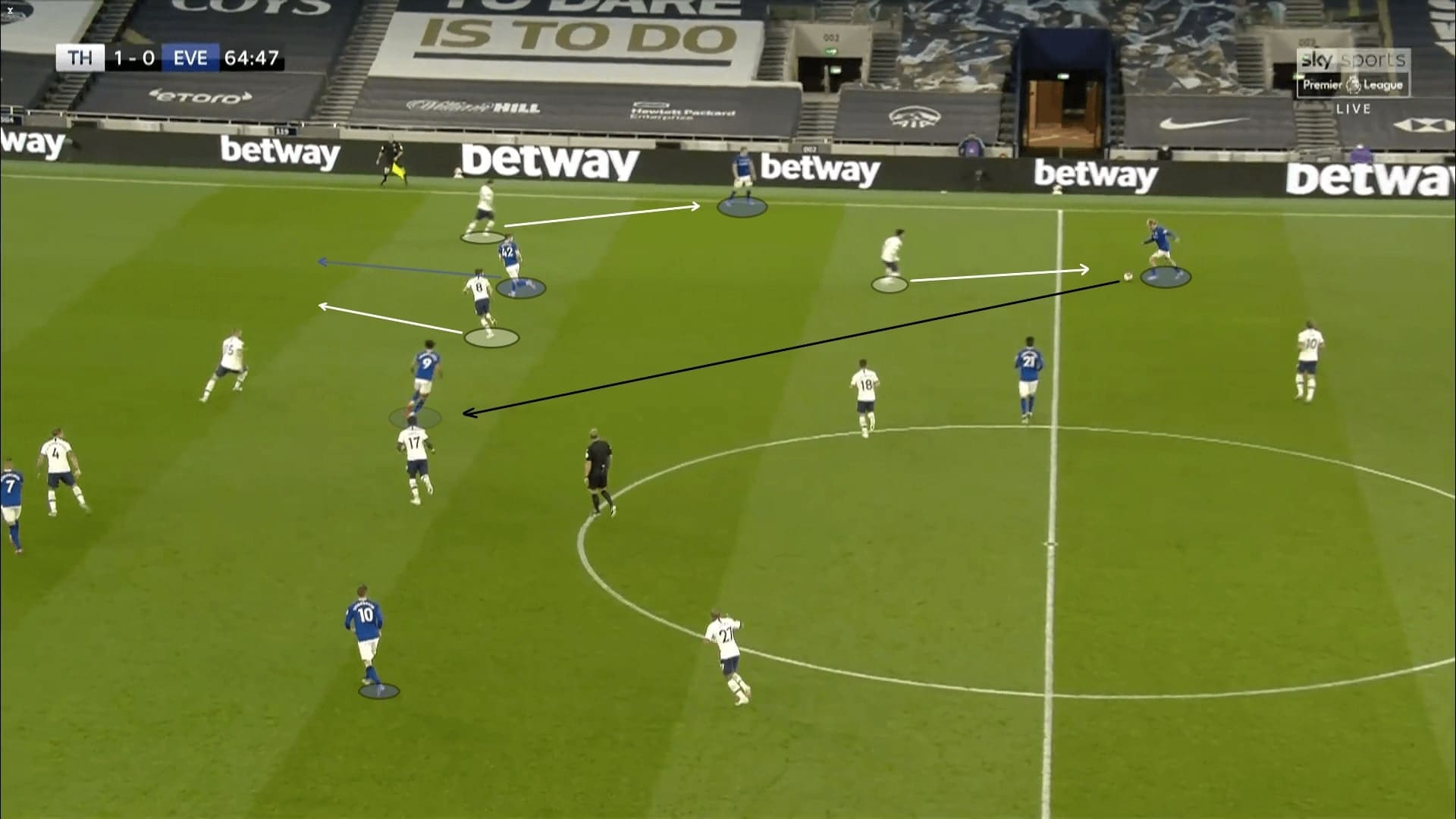
However, a coin has two sides and taking Iwobi off allowed Tottenham to attack easier. Now, the defensive block was a 4-4-2: T. Davies and Gomes at the centre, Sigurðsson and Gordon at both flanks.
Hindered by the opponents behind, the midfielders were not supporting the strikers enough, this issue was carried forward into the second half. We highlighted the vertical distances of the Everton layers below, the midfielders could not push higher as three Lilywhites were behind. This allowed Tottenham to attack in their own tempo and rhythm.
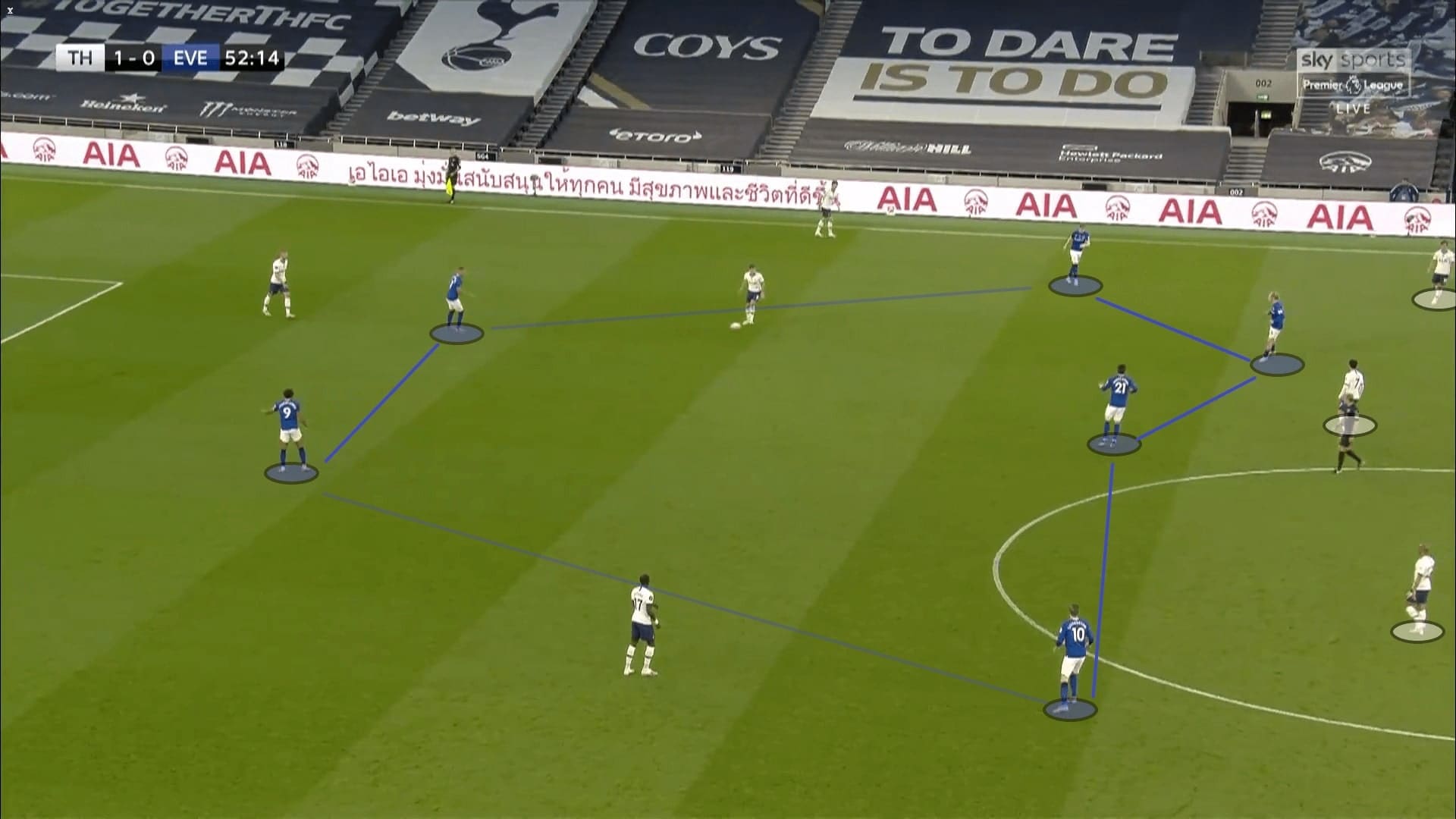
Also, Everton did not control Aurier tightly without Iwobi. The Ivorian’s wide positioning stretched the defence and opened the horizontal gaps between players. This allowed Tottenham to enter the final third with some ground passes which bypassed the midfield directly.
Here, Aurier has drawn Sigurðsson wide, and Alderweireld could feed into Moura’s feet with a vertical pass. Two layers were bypassed in the process.
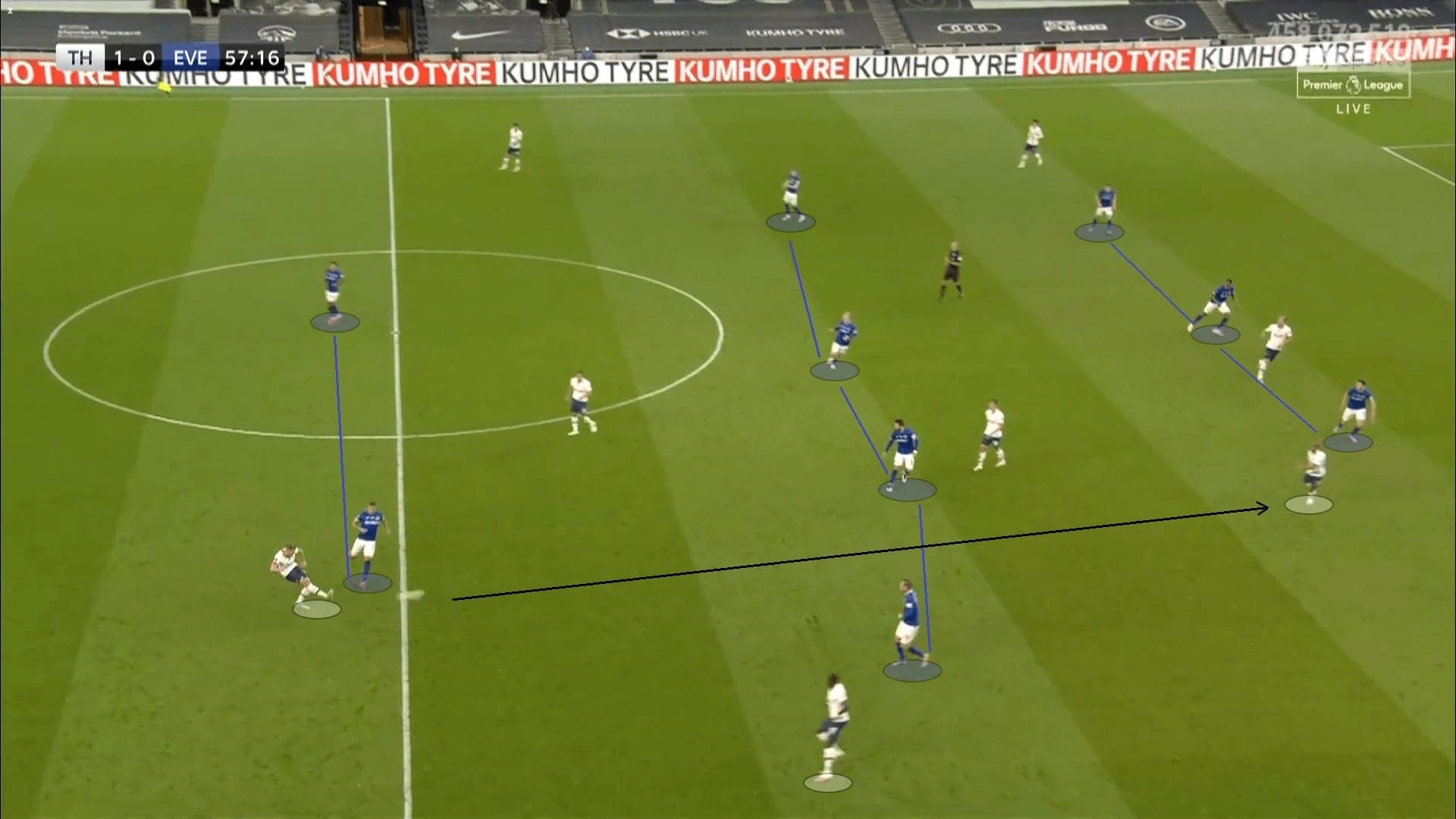
In the Everton defensive third, the left-back, Digne had to deal with Aurier. When the Frenchman defender has stepped out, spaces appeared at the half-spaces for the Tottenham inverted winger to run into.
Here, Moura perceived the spaces and exploited that gap, who was then released by Aurier. But, the Evertonians were alert to track most runs, and T. Davies reacted by following the Brazilian winger tightly. Usually, these tracks prevented the receiver from turning and ensured the attack could not further develop.
To sum up, the introduction of Gordon did help Everton to attack more effectively, but this also had a cost at the other end. Considering the score line, the change was necessary, at least Ancelotti has tried. Tottenham drew a lot of fouls as the Everton attacks have progressed, but these set-piece opportunities were not fully utilized. As a reference, 0.35 xG from a total of 0.49 was generated in the second half.
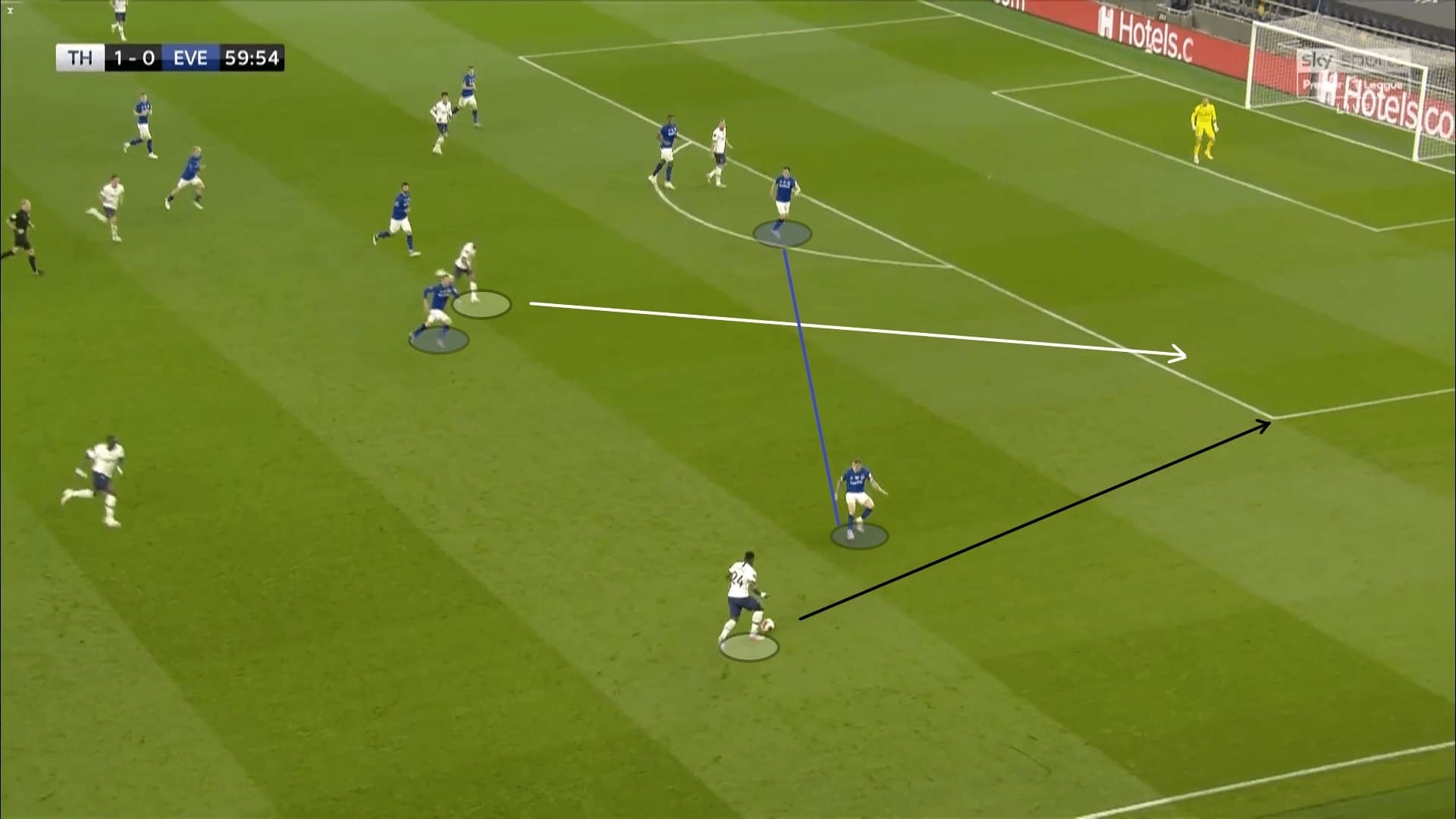
Transition phases
In fact, Tottenham looked more threatening in the transition phases. Not only it was because of the spaces available at the exposed backline, but also the behaviour of the front players to attack the spaces.
We have mentioned in the previous analysis against Manchester United as well, which Kane tended to drop and operated as a “false-9”. The term was not important, the only meaning was this represented his deep movements to receive the ball, out of the backline.
To compensate and continue to attack the backline, the Tottenham wingers came narrowly in the counter-attacks. Here, Kane dropped deep, and a decisional crisis was created on the defenders. Mason Holgate has decided not to follow as Moura and Son were dashing forward. So, this has bought Kane time to turn and face to the goal, the attack has continued.
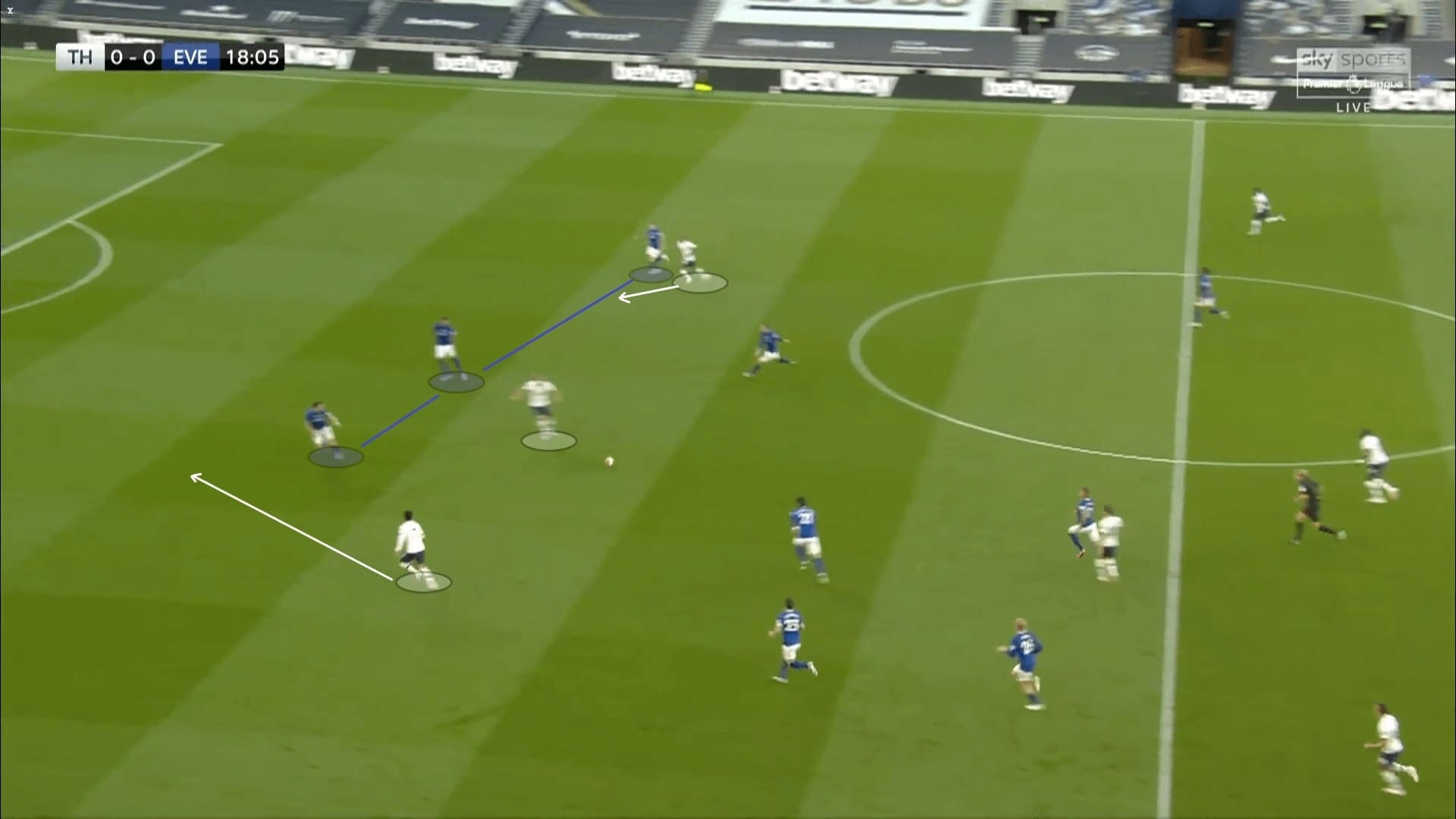
In another situation, the centre-back has followed, it was Mina here. Then, the gap was created at the backline and the inverted wingers were keen to exploit those spaces. It was Son below who capitalized on spaces behind Mina, and being released in the offensive third.
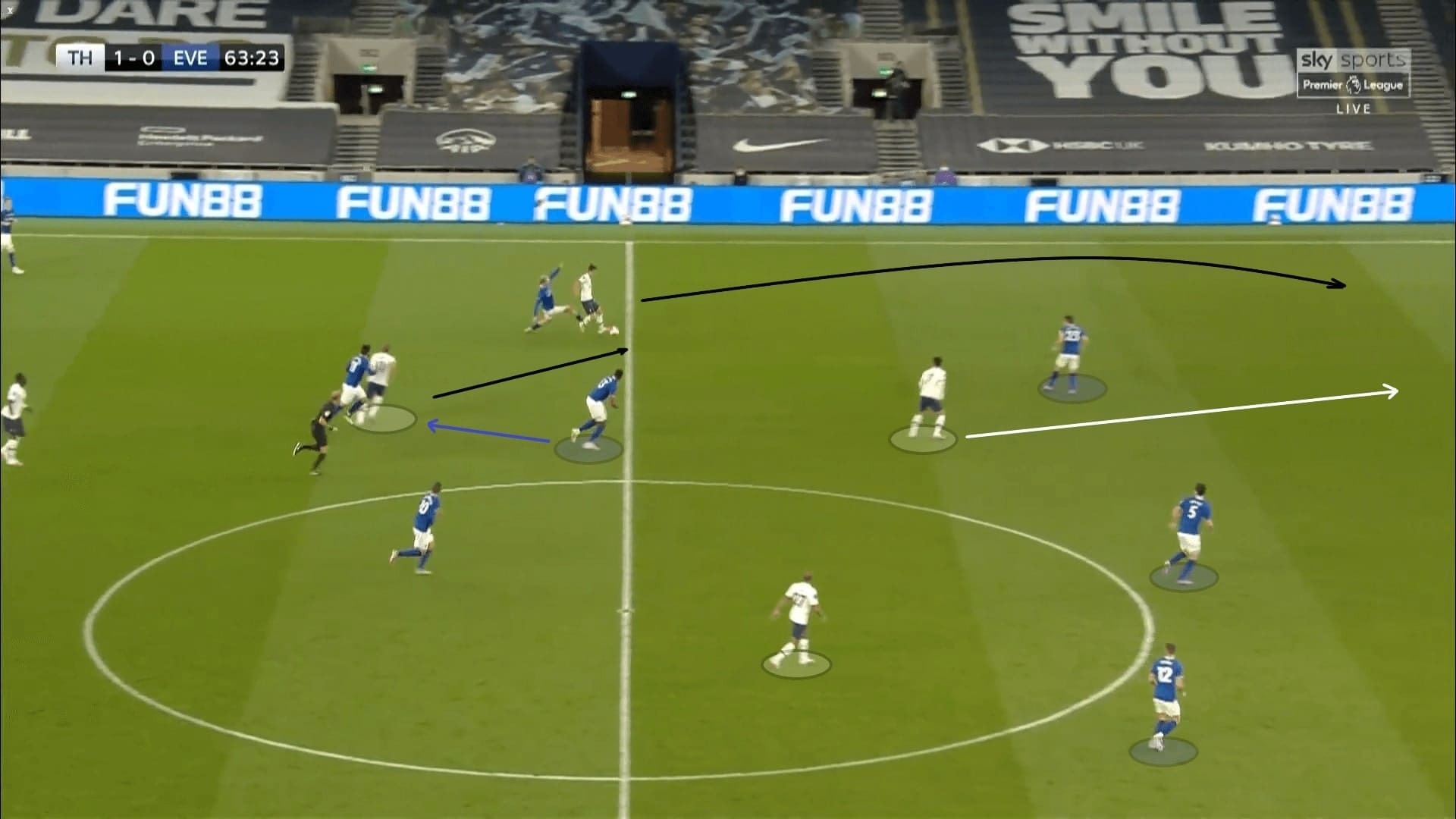
The defensive transitions of Tottenham were also tough, as they controlled the pair of Everton strikers quite well. The centre-backs would not hesitate to step out and pressure from the receivers’ back. This prevented Richarlison from turning and allowed the others to recover their position, ideally, surrounding the receiver and regain possession.
So, the basic setup and assumption were shown below. Considering a maximum of two Everton strikers were waiting for the counter-attacks, with Sissoko and the centre-backs, Tottenham had three against two. The extra man allowed the Lilywhites to support each other in this phase, and Everton seldom create chances through the offensive transitions.
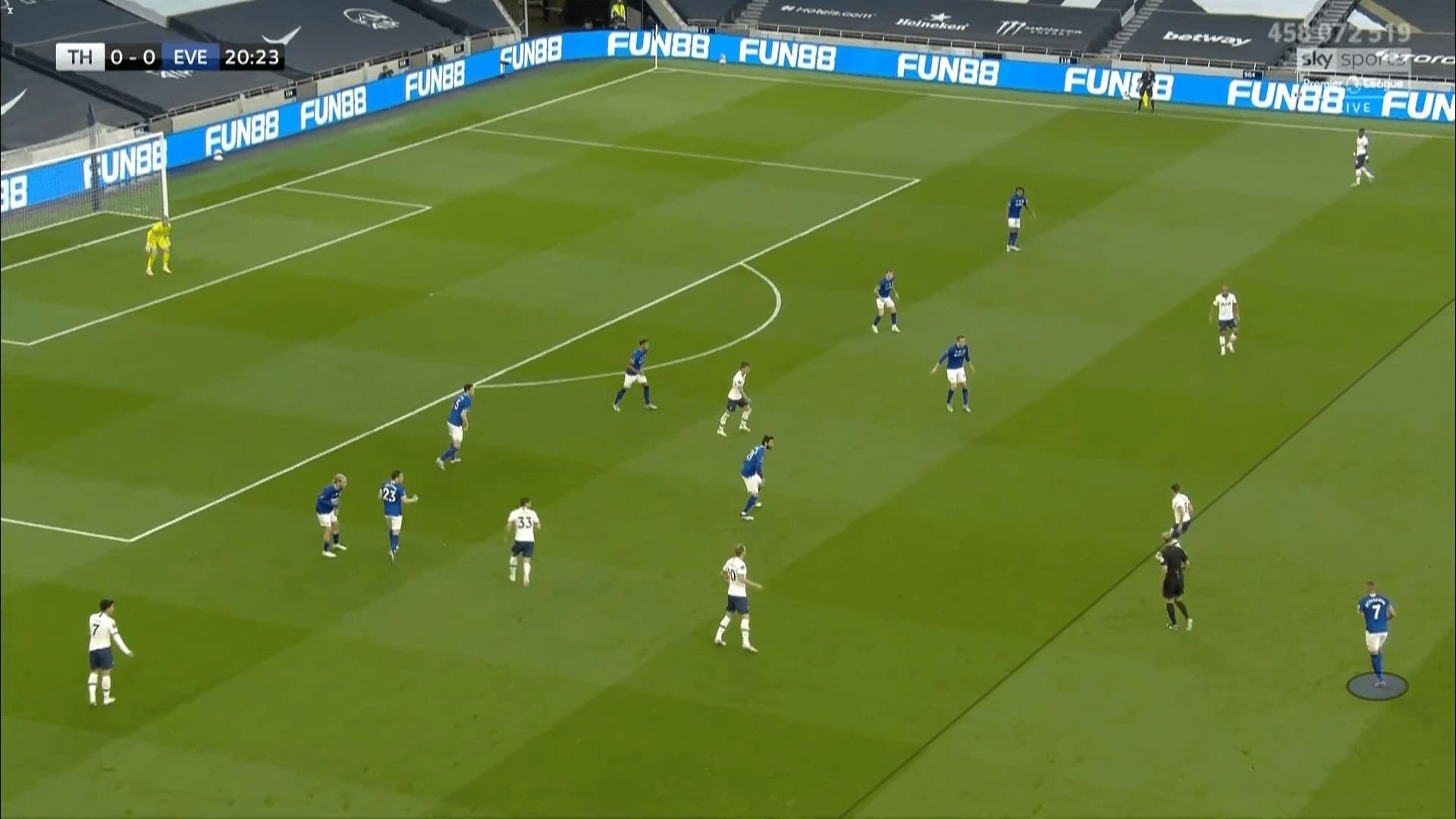
Final remarks
Maybe, it was a boring game as not many huge opportunities were created. But, it was still fascinating when we are looking into the tactics of Mourinho and Ancelotti, two world-class managers in the world. Tottenham had some luck to score with Keane’s own goal, but their defence was solid to keep a clean sheet in this game.
Everton have adopted several intriguing tactics to develop the attacks, and the impact of Gordon was huge after the break. This boy is an interesting one and we should keep an eye on him!





Comments